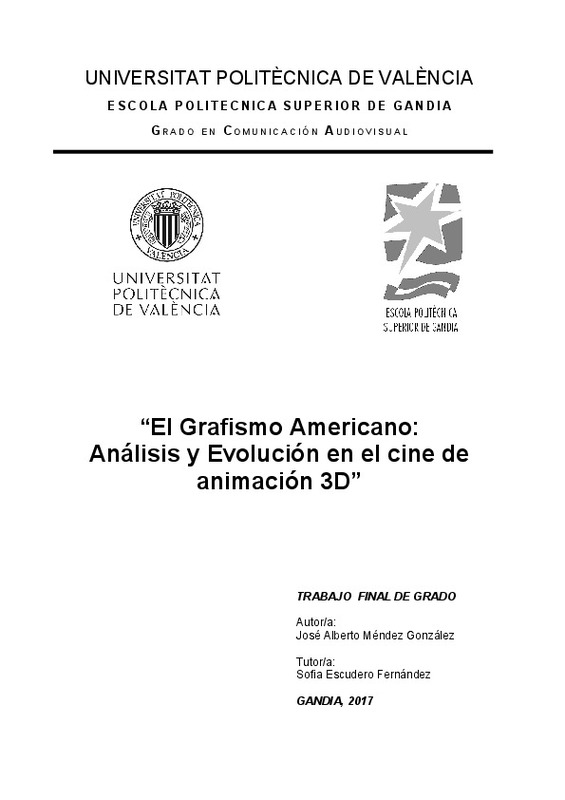|
Resumen:
|
El grafismo es el arte de elaborar un discurso audiovisual donde se utilizan elementos
gráficos en movimiento como pueden ser la tipografía, el color o las figuras geométricas. Se ha
utilizado desde prácticamente los ...[+]
El grafismo es el arte de elaborar un discurso audiovisual donde se utilizan elementos
gráficos en movimiento como pueden ser la tipografía, el color o las figuras geométricas. Se ha
utilizado desde prácticamente los inicios del cine, aunque en la actualidad se ha profesionalizado
tanto que ha llegado a convertirse en una forma de expresión artística y comunicativa más.
Aunque el grafismo en el cine de animación no se popularizó hasta finales de los 90, en Japón,
películas como Ghost in the Shell (1995) ya añadían grafismo para introducir al espectador en un
mundo digitalizado controlado por las máquinas. Eso no quiere decir, que no hubiera
precedentes, ya que Alfred Hitchcock fue pionero en utilizar grafismo en sus películas. Un
ejemplo destacable es Vertigo (1958) donde el maestro y pionero del grafismo, Saul Bass,
muestra la manera de preparar al espectador para lo que va a ver más adelante.
Dentro del grafismo podemos distinguir diferentes funciones que se utilizan según el tipo de
discurso audiovisual que se quiera transmitir. Estas funciones pueden ser organizativas, utilizada
en la televisión para poder diferenciar un contenido audiovisual de otro; informativas, para que a
través de una serie de imágenes puedas informarte de una situación en concreto; persuasivas,
utilizadas mayormente en la publicidad para intentar captar la atención al espectador e intentar
venderle un producto; y simbólica, donde una serie de elementos gráficos en movimiento ayudan
al espectador a reconocer el producto.
Otra característica del grafismo audiovisual es el discurso. Toda pieza de grafismo tiene un
mensaje que quiere transmitir, algunos más claros que otros. Normalmente el discurso
audiovisual se divide en dos partes: Discurso Semántico y Discurso Estético.
Dentro de la creación de un grafismo, deben tenerse en cuenta diferentes elementos que ayudan
a crear el discurso. Estos elementos suelen utilizarse de forma colectiva, pero, para poder hacer
un discurso claro hay que pensar en cada uno de ellos. Suelen dividirse en espacio, tiempo e
imagen. Si estos elementos se tienen en cuenta a la hora de construir un discurso, ayudan a un
mejor entendimiento de este.
Todas estas características se han creado a partir de los precedentes tanto en el mundo de la
animación como en el mundo del grafismo. En este último, han habido grandes diseñadores que
han ayudado a que evolucione y se profesionalice. Grafistas como Saul Bass, Maurice Binder,
Wayne Fitzgerald, Richar y Robert Greenberg y Kyle Cooper, han inspirado a la mayoría de
personas que se dedican a esta disciplina. Sin estos grafistas, los créditos de películas como
Shrek, Las aventuras de Tintin: El secreto del Unicornio, Monster S.A, Wall-E y Kung Fu Panda,
posiblemente no hubieran sido lo mismo.
[-]
Motion Graphics is the art of elaborating an audiovisual discourse in which it aspects such as
graphic elements in movement as the typography, the colour or the geometric forms are used. It
has been used since the origins ...[+]
Motion Graphics is the art of elaborating an audiovisual discourse in which it aspects such as
graphic elements in movement as the typography, the colour or the geometric forms are used. It
has been used since the origins of films, although currently it has acquired a professional status,
being transformed into another form of artistic and communicative expression.
Despite the use of Motion Graphics in animated films was not popular until the late 90's, in Japan,
films such as Ghost in the Shell in 1995 already added Motion Graphics in a film in order to
introduce the audience into a digitalized world controlled by machines, although that does not
indicate the inexistence of precedents, being Alfred Hithcock a pioneer in using Motion Graphics
in his movies. A remarkable instance of this use is Vertigo (1958) in which the master and
pioneer of Motion Graphics, Saul Bass shows the way to prepare the spectator for what is going
to happen.
Different functions can be distinguished inside Motion Graphics, functions that are used
according to the type of audiovisual discourse to be transmitted. These functions can be
organizational, used in television to differentiate one audiovisual content from another;
informative, in order to be informed of a concrete situation through a series of images;
persuasive, used mostly in advertising with the intention of attracting the attention of the viewer
and trying to sell you a product; and symbolic, in which a string of graphic elements in movement
helps the spectator to recognize the product.
Another characteristic of the audiovisual Motion Graphics is the discourse. Every piece of Motion
Graphics has a message to be transmitted, some of them clearer than others. Usually, the
audiovisual discourse is divided into two parts: Semantic Discourse and Aesthetic Discourse.
Inside the creation of a Motion Graphics, some elements have to be taken into account in order to
create the discourse. These elements tend to be used collectively, but, to build a clear discourse,
each one of these elements have to be pondered individually. It tends to be divided into space,
time and image. If these elements are considered at the time of constructing a discourse, they
help to establish a better process for its comprehension.
All these characteristics have been created from their precedents both in the world of animation
and in the world of Motion Graphics. In the latter, there have been great designers that have
contributed to the evolution and professionalization of Motion Graphics. Graphic artists such as
Saul Bass, Maurice Binder, Wayne Fitzgerald, Richard and Robert Greenberg and Kyle Cooper,
have been an inspiration for a wide amount of professionals dedicated to this discipline. Without
these graphic designers the motion credits of films such as Shrek, The Adventures of Tintin: The
Secret of Unicorn, Monsters Inc, Wall-E and Kung Fu Panda would not have been the same.
[-]
|







